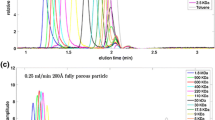Abstract
In this study, we have investigated sedimentation velocity ultracentrifugation (AUC-SV), size exclusion chromatography (SEC), and circular dichroism (CD) methods for the detection and quantitation of protein aggregates using recombinant acid alpha-glucosidase (rhGAA) as a model. The results of this study showed that the formation and molecular weight distribution of rhGAA aggregated species were dependent upon the formulation conditions as well as the storage or stress conditions used to induce aggregation. The utility of CD as a probe for non-native, aggregated species was affirmed, as this method was sensitive to rhGAA aggregation levels of ≤4%. An extensive evaluation of AUC-SV variability was performed using nine levels of spiked rhGAA aggregate that were analyzed on six occasions. Based on our data, the precision of the AUC-SV results increased with increasing levels of aggregate, with a mean RSD of 37.2%. The limit of quantitation (LOQ) for the AUC-SV method, which was based on a Precision criterion of RSD <20%, was determined to be ≥3% aggregated rhGAA. The Precision and LOQ of the SEC method, determined using the same rhGAA sample set, was found to be 3.8% and ≥0.2%, respectively. In general, there was good agreement between the levels of aggregated rhGAA determined using the AUC-SV and SEC methods, with a slight positive bias noted for the AUC-SV results. These studies emphasize the value of applying multiple, well-characterized analytical tools in the evaluation of therapeutic protein aggregation.





Similar content being viewed by others
Abbreviations
- AUC-SV:
-
Sedimentation velocity analytical ultracentrifugation
- CD:
-
Circular dichroism spectroscopy
- c(S):
-
Continuous size distribution
- rhGAA:
-
Recombinant human acid α-glucosidase
- rhGAA-FP:
-
Recombinant human acid α-glucosidase, finished product
- RI:
-
Radial invariant noise
- TI:
-
Time invariant noise
References
Hermeling S, Schellekens H, Maas C, Gebbink MFBG, Crommelin DJA, Jiskoot W. Antibody response to aggregated human interferon alpha2b in wild-type and transgenic immune tolerant mice depends on type and level of aggregation. J Pharm Sci. 2006;95:1084–96.
Rosenberg A. Effects of protein aggregates: an immunologic perspective. AAPS J. 2006;8:E501–7.
De Groot AS, Scott DW. Immunogenicity of protein therapeutics. Trends Immunol. 2007;28:482–90.
Ribarska JT, Jolevska ST, Panovska AP, Dimitrovska A. Studying the formation of aggregates in recombinant human granulocyte-colony stimulating factor (rHuG-CSF), lenograstim, using size exclusion chromatography and SDS-PAGE. Acta Pharm. 2008;58:199–206.
Berkowitz SA. Role of analytical ultracentrifugation in assessing the aggregation of protein biopharmaceuticals. AAPS J. 2006;8:E590–605.
Liu J, Andya JD, Shire SJ. A critical review of analytical ultracentrifugation and field flow fractionation methods for measuring protein aggregation. AAPS J. 2006;8:E580–9.
Lebowitz J, Lewis MS, Schuck P. Modern analytical ultracentrifugation in protein science: a tutorial review. Protein Sci. 2002;11:2067–79.
Schuck P. Size-distribution analysis of macromolecules by sedimentation velocity ultracentrifugation and lamm equation modeling. Biophys J. 2000;78:1606–19.
Gabrielson JP, Brader ML, Pekar AH, Mathis KB, Winter G, Carpenter JF. Quantitation of aggregate levels in a recombinant humanized monoclonal antibody formulation by size exclusion chromatography, asymmetrical flow field flow fractionation, and sedimentation velocity. J Pharm Sci 2007;96:268–79.
McVie-Wylie AJ, Lee KL, Qiu H, Jin X, Do H, Gotschall R. Biochemical and pharmacological characterization of different recombinant acid alpha-glucosidase preparations evaluated for the treatment of Pompe disease. Molec Genet Metab 2008;94:448–55.
Moreland RJ, Jin X, Zhang XK, Decker RW, Albee KL, Lee KL. Lysosomal acid alpha glucosidase consists of four different peptides processed from a single chain precursor. J Biol Chem. 2005;280:6780–91.
Kueltzo LA, Wang W, Randolph TW, Carpenter JF. Effects of solution conditions, processing parameters, and container materials on aggregation of a monoclonal antibody during freeze-thawing. J Pharm Sci. 2008;97:1801–12.
Maas C, Hermeling S, Bouma B, Jiskoot W, Gebbink MFBG. A role for protein misfolding in immunogenicity of biopharmaceuticals. J Biol Chem. 2006;282:2229–36.
Friefelder D. Physical biochemistry, applications to biochemistry and molecular biology. San Francisco: Freeman; 1976.
Schmid FX. Spectral methods of characterizing protein conformation and conformational changes. Oxford: IRL Press at Oxford University Press; 1989.
Kendrick BS, Cleland JL, Lam X, Nguyen T, Randolph TW, Manning MC. Aggregation of recombinant human interferon gamma: kinetics and structural transitions. J Pharm Sci. 1998;87:1069–76.
Brown PH, Balbo A, Schuck P. A Bayesian approach for quantifying trace amounts of antibody aggregates by sedimentation velocity analytical ultracentrifugation. AAPS J. 2008;10:481–93.
Gabrielson JP, Arthur KK, Kendrick BS, Randolph TW, Stoner MR. Common excipients impair detection of protein aggregates during sedimentation velocity analytical ultracentrifugation. J Pharm Sci. 2009:50–62.
Pekar A, Sukumar M. Quantitation of aggregates in therapeutic proteins using sedimentation velocity analytical ultracentrifugation: practical considerations that affect precision and accuracy. Anal Biochem. 2007;367:225–37.
Gabrielson JP, Randolph TW, Kendrick BS, Stoner MR. Sedimentation velocity analytical ultracentrifugation and SEDFIT/c(s): limits of quantitation for a monoclonal antibody system. Anal Biochem. 2007;361:24–30.
Acknowledgments
The authors would like to thank Robert Mattaliano, Scott Van Patten, and Jonathan Kingsbury for critical review of this manuscript and Michael Rose for statistical analyses.
Author information
Authors and Affiliations
Corresponding author
Rights and permissions
About this article
Cite this article
Hughes, H., Morgan, C., Brunyak, E. et al. A Multi-Tiered Analytical Approach For the Analysis and Quantitation of High-Molecular-Weight Aggregates in a Recombinant Therapeutic Glycoprotein. AAPS J 11, 335–341 (2009). https://doi.org/10.1208/s12248-009-9108-1
Received:
Accepted:
Published:
Issue Date:
DOI: https://doi.org/10.1208/s12248-009-9108-1




